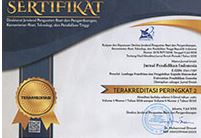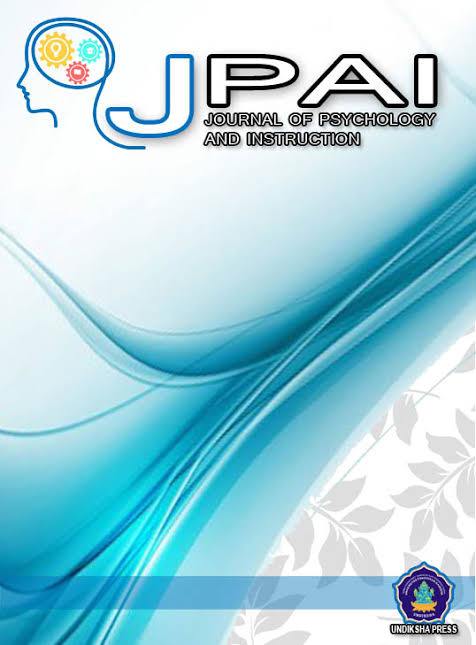ENGLISH LEARNING MOTIVATION AND SPEAKING ABILITY
DOI:
https://doi.org/10.23887/jpai.v2i2.15979Abstract
The aim of communicative language teaching is enable learners to communicate in the target language. A learner is sued to perform the micro and macro components in each utterance produced. Consequently, students need to know the linguistics forms, meanings and functions of that target language. They need to know that many different forms can be used to perform a function and also that single form can often serve a variety of functions. Students must be able to choose from among these the most appropriate form, given the social context and manage the process of negotiating meaning with their interlocutors. However, knowing learner’s English learning motivation is an urgent variable to be considered in creating conducive atmosphere classroom which will raise the learners to do more toward speaking achievement. The aim of this study is to know and describe the English learning motivation affecting students’ speaking ability of 48 students of XI grade of science program at catholic senior of Saint Ignasius Loyola Labuan Bajo, West Flores, Indonesia. Correlation design with purposive procedure applied in this research. Data were collected through questionnaire, interview, and students’ speaking document. Result shows that motivation is significantly affecting students’ speaking ability.References
Al-Tamimi, A., and Shuib, M. (2009). Motivation and attitudes towards learning English: A study of petroleum engineering undergraduates at Hadhramout university of sciences and technology. GEMA online journal of language studies, 9 (2), 29-55.
Al-Qahtani, M, F. (2013). Relationship between English language, learning strategies, attitudes, motivation, and students’ academic achievement. Education in medicine journal, 5 (3), 19-29. DOI: 10.5959/eimj.v5i3.124.
Anjomshoa,L., & Sadighi, F. (2015). The importance of motivation in second language acquisition. International Journal on Studies in English Language and Literature, 3 (2), 126-137.
Astiti, S, N. (2012). The effect of cooperative learning strategy (Jigsaw II technique) and achievement motivation on the speaking achievement of the tenth grade students of SMKN 3 Singaraja (Thesis). Singaraja: Universitas Pendidikan Ganesha Singaraja.
Atkinson, R. H., & Longman, D. G. (1985). Reading enhancement and development. New York: West Publishing Company.
Brown, D, H. (2004). Language assessment: Principles and classroom practices. New York: Addison Wesly Longman Inc.
Brown, D. H. (2007). Principles of language learning and teaching (fifth edition). San Fransisco: Pearson Education, Inc.
Burnkart, G. S. (1998). Spoken language: What it is and how to teach it. Washington: Center for Applied Linguistics.
Burns, A & Joyce,H. (1999). Focus on Speaking. Sydney: Macquarie University.
Chalak, A & Kassaian, Z. (2010). Motivation and attitudes of Iranian undergraduate EFL students towards learning English. GEMA online journal of language studies, 10 (2), p.37-56.
Celce-Murcia, M. (2001). Teaching English as a Second or Foreign Language (Third Edition). USA: Heinle & Heinle Thomson Learning, Inc.
Chiu-Ping Huang, Chiu-Ping. (2010). Exploring factors affecting the use of oral communication strategies (research publication). Lunghwa: Lunghwa University of Science and Technology.
Chomsky, N. (1965). Aspects of the theory of syntax (p.10). Cambridge: MIT Press.
Degang, M. (2010). Motivation toward English language learning of the second year undergraduate Thai students majoring in business English at an English-medium university (thesis). Srinakharinwirot: Srinakharinwirot University.
Dörnyei, Z. (1998). Motivation in second and foreign language learning. Language Teaching, 31, 117-35.
Gardner, R. C. (1985) Social psychology and second language learning: The role of attitudes and motivation. London: Edward Arnold.
Fromkin, V. A. (2003). Linguistics: An introduction to linguistic theory. Oxford: Blackwell Publishing Ltd.
Genc, z, s., & Aydin, F. (2017). An analysis of learners’ motivation and attitudes toward learning English language at tertiary level in Turkish EFL context. English language teaching journal, 10 (4), 35-44. DOI: 10.5539/elt.v10n4p35.
Ghanbarpour, M. (2016).Willingness to communicate, linguistic self-confidence, and language-use anxiety: the Iranian EFLcontext. Theory and practice in language studies, 6 (12), 2265-2271. DOI: http://dx.doi.org/10.17507/tpls.0612.05.
Harmer, J. (2007). How to (new edition). England: Pearson Longman.
Hong, Y, C., & Ganapathy, M. (2017). To investigate ESL students’ instrumental and integrative motivation towards English language learning in a Chinese school in Penang: Case study. English language teaching journal, 10 (9), 17-35. DOI: 10.5539/elt.v10n9p17.
Hymes, D. (1972). On communicative competence. In Pride, J.B.; Holmes, J. Sociolinguistics: selected readings (p. 269–293). Harmondsworth: Penguin.
Kayi, H. (2006). Teaching Activities: Activities to Promote Speaking in a Second Language. Retrieved July 26, 2018, from https://www.scribd.com/document/251204059/Teaching-Speaking-Activities to promote in a second language.
Kitjaroonchai, N., & Kitjaroonchai, T. (2012). Motivation toward English language learning of Thai students majoring in English at Asia-pacific international university. Catalyst journal, 7 (1),21- 38.
Kitjaroonchai, N. (2012). Motivation toward English language learning of students in secondary and high schools in education service area office 4, Saraburi province, Thailand. International journal of language and linguistics, 1 (1), 22-33. DOI: 10.11648/j.ijll.20130101.14.
Krashen, S. (1988). Second language acquisition and second language learning. London: Prentice Hall International (UK).
Larsen-Freeman, D. (2003). Techniques and principles in language teaching (second edition). Oxford: Oxford University Press.
Lazaraton, A. (2001). Teaching oral skills. In: Celce-Mulcia, M (eds) Teaching English as a second or foreign language (third edition). New York: Heinle&Heinle, Ltd.
Li, P & Pan, G. (2009). The relationship between motivation and achievement: a survey of the study motivation of English majors in Qingdao agricultural university. English language teaching, 2 (1), 123-128.
Long, C., Ming, Z., & Chen, L. (2013). The study of student motivation on English learning in junior middle school: A case study of no.5 middle school in Gejiu. English language teaching, 6 (9), 136-145. DOI: 10.5539/elt.v6n9p136.
Lucas, et al. (2010). A study on the intrinsic motivation factors in second language learning among selected freshman students. Philippine ESL journal, 4, 3-23.
Piniel, K., & Csizér, K. (2013). L2 motivation, anxiety and self-efficacy: the interrelationship of individual variables in the secondary school context. Studies in second language learning and teaching, 3 (4), 523-550.
Schunk, D, H., Pintrich, P, R., Meece, J, L. (2008). Motivation in education: theory, research, and applications (third edition). New Jersey: Pearson Education, Inc.
Thornburry, S. (2005). How to teach speaking. England: Pearson Educated Limited.
Tuan, N, H & Mai, T,N. (2015). Factors affecting students’ speaking performance at Le Thanh Hien high school. Asian journal of educational research, 3 (2) 8-23.
Uno, H, B. (2009). Teori motivasi & pengukurannya: Analisi di bidang pendidikan. Jakarta: Bumi Aksara.










